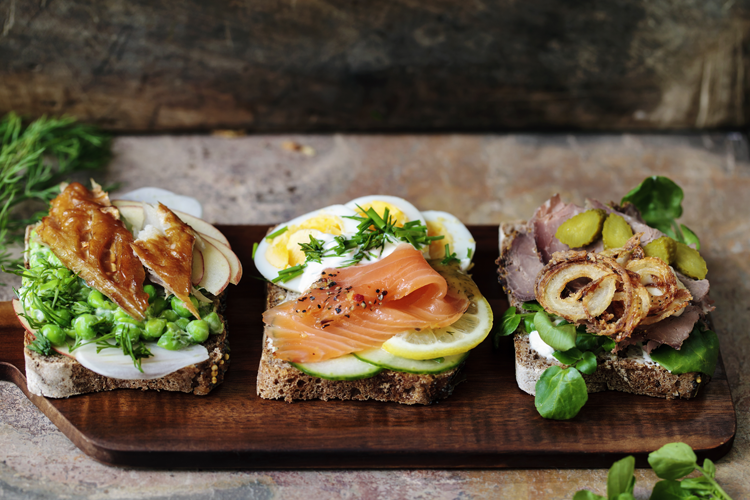Blog
Eating New Nordic for health
 If the T.V. series is anything to go by, Vikings can be thought to have glowing skin, luscious locks, and kick-ass strength (and, you know, keen on that pillaging business).
If the T.V. series is anything to go by, Vikings can be thought to have glowing skin, luscious locks, and kick-ass strength (and, you know, keen on that pillaging business).
But the glorified Hollywood take on the ancient Nordic warriors aside, healthy skin, hair, and strength are signs of good health and diet. To support this notion, a recent report in The Lancet that measured the UN’s health-related Sustainable Development Goals named Iceland and Sweden as the 1st and 3rd healthiest countries.
And considering a modern take on the Nordic diet seems to promote other wellness benefits such as weight loss, increased insulin sensitivity, and improvements to cardiovascular health like lowered blood pressure,1;2 it seems our northern fellows are clearly onto something.
The New Nordic Diet takes inspiration from foods traditionally eaten or locally sourced to Denmark, Finland, Iceland, Norway, and Sweden.3 It was created in the early 21st century to encourage healthy eating, addressing unsustainable farming practices and the rise of diet-related health issues.
Nordic nosh shares characteristics with its Mediterranean cousin to the south. There is a great focus on whole food that is fresh, fermented, and packed with fibre.
Eat like a Nordic
Here are the key components of what make people of the Nord so well, and their diet so appealing:
Fibre
Vegetables and fruit play a significant role in the every day of the Nordic diet, as well as some whole grain and legumes.
Think berries, cabbage and root veg, and some dark rye sourdough, oats, peas and beans to get an array of fibre into your every day, and help your bowels sing!
Good fats
Essential fatty acids (EFA) have been found in many studies to be helpful to heart and neurological health, as well as offer some powerful anti-inflammatory activity. And a good dose supplied by whole food fats leaves you feeling fuller for longer!
Oily fish, locally caught, can offer up EFA, along with flaxseeds, walnuts, and chia seeds. Also use high-quality oils for your cooking and dressings, such as olive oil (though this is more common to the Mediterranean style diet), which have undergone minimal processing to be bottled for your enjoyment.
Fermented foods
We love fermented foods here at That Sugar. And this ancient practice of food preparation and preservation may help support the health of the intestinal microbiome. This can go on to positively impact digestive, immune, cardiovascular and overall health, as well as encourage antioxidant and anti-inflammatory activity. Cultured dairy products are common to the Nordic diet, serving up foods like yoghurt and the fermented milk creation, Filmjolk.
Growing your own, and buying locally and seasonally
Whether you are able (or interested) to grow your own food or simply buy from a local grower food that is in season, you will be upping the nutrient density and taste factor.
Berries are one of the few fruits grown well and in abundance in the chilly north. They also happen to be low GI and a major supply of powerful phytochemicals in that have a huge array of health benefits, including improving cardiovascular risk factors, improve memory and learning, and protect against cellular damage (say hello to that glowing skin and luscious locks!).
And we should probably mention that eating locally reduces all that messy environmental impact from growing, transporting and storing foods out of season.
Other foods to include are eggs (free-range and where possible, organic), and some poultry and meat that is high quality (i.e. grass-fed, free-range, wild, organic), whilst limiting intake of heavily processed foods and sweets.
Get moving
Again, like those of the Mediterranean diet, enjoying some form of physical movement each and every day is part of the lifestyle in the Nordic countries.
You may have heard of Nordic Walking, which has been found in numerous studies to do wonders for weight loss, heart health, exercise capacity and quality of life, whilst having little impact on joints.4;5
Just eat real food
We aren’t saying this is some brand-spanking-new-miracle-diet. In fact, the essence of this way of eating is quite simple, sharing what the very well studied Mediterranean diet has to offer, and something we go on about here at That Sugar – to just eat real food.
All in all, we can conclude that the health benefits being seen in new research with the New Nordic Diet comes down to eating real, whole foods, and avoiding the highly processed or sugar laden packaged stuff!
By Angela Johnson (BHSc Nut. Med.)
References:
- Poulsen, SK Due, A Jordy, AB Kiens, B Stark, KD Stender, S Holst, C Astrup, A & Larsen, TM 2014, ‘Health effect of the New Nordic Diet in adults with increased waist circumference: a 6-mo randomized controlled trial’, American Journal of Clinical Nutrition, vol. 99, no. 1, pp. 35-45.
- Uusitupa, M, Hermansen, K, Savolainen, MJ, Schwab, U, Kolehmainen, M, Brader, L, Mortensen, LS, Cloetens, L, Johansson-Persson, A, Onning, G, Landin-Olsson, M, Herzig, K, Hukkanen, J, Rosqvist, F, Iggman, D, Paananen, J, Pulkki, KJ, Siloaho, M, Dragsted, L, Barri, T, Overvad, K, Bach Knudsen, KE, Hedemann, MS, Arner, P, Dahlman, I, Borge, GA, Baardseth, P, Ulven, SM, Gunnarsdottir, I, Jonsdottir, S, Thorsdottir, I, OreA iA, M, Poutanen, KS, Riserus, U, & Akesson, B 2013, ‘Effects of an isocaloric healthy Nordic diet on insulin sensitivity, lipid profile and inflammation markers in metabolic syndrome – a randomized study (SYSDIET)’, Journal of Internal Medicine, no. 1, p. 52.
- Corliss, J 2015, ‘The Nordic diet: Healthy eating with an eco-friendly bent’, Harvard Health Blog, Harvard Medical School Health Publications, viewed 10 October 2016, <http://www.health.harvard.edu/blog/the-nordic-diet-healthy-fare-with-an-eco-friendly-bent-201511198673>
- Mathieson, S, & Lin, CC 2014, ‘Health benefits of Nordic walking; a systematic review’, British Journal Of Sports Medicine, vol. 48, no. 21, pp. 1577-1578.
- Tschentscher, M, Niederseer, D, & Niebauer, J 2013, ‘Review and special articles: Health Benefits of Nordic Walking. A Systematic Review’, American Journal of Preventive Medicine, vol. 44, pp. 76-84.











